Recent Articles
Popular Makes
Body Types
10 Things You Need to Know About the 2017 Toyota Prius Prime

2017 Toyota Prius Prime exterior front by Ron Sessions ・ Photo by Ron Sessions
When it comes to fuel-stingy gas-electric hybrid cars and SUVs, no automaker has more experience or offers more choices than Toyota. There are seven hybrid offerings from Toyota’s luxury division, Lexus: CT, ES, GS, LC, LS, NX and RX. And over at the Toyota brand, there’s the Avalon, Camry, Highlander and RAV4 hybrids plus four, count ‘em, four different Prius models. The Prius lineup now includes the tiny, entry-level Prius C, extra-roomy, wagon-like Prius V, mainstream midsize Prius Liftback (an all-new version which just debuted for 2016) and the new-for-2017 Toyota Prius Prime.
The Prime is the newest version of the Prius Plug-in. It comes in three well-equipped versions: the $27,100 Prime Plus, the $28,800 Prime Premium and the $33,100 Prime Advanced.
1) You really need to plug it in.
The thing is, you really should plug the Prime in to get the most out of it. Like other Prius models, it blends the output of a 4-cylinder gas engine and electric power to drive the front wheels. But the Prime also has a bigger battery than the regular Prius that allows it to operate solely on electric power for the first 25 miles, thereby boosting your mileage. The catch is the battery has to have a full charge, and the only way to do that is to first plug it into an electrical outlet. The charge port is on the passenger-side rear fender, near the taillight. The Prime comes with a charge cable for a conventional 120-volt wall socket but charging up with that will take roughly 5.5 hours. The smart move is to get a level-2 charge cable and have a 240-volt outlet installed in your garage, which takes charging time down to just two hours.
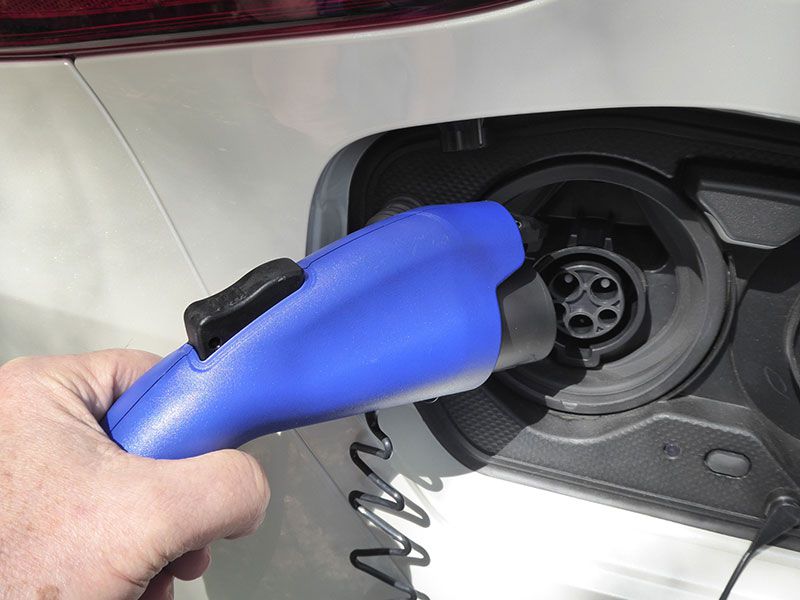
Photo by Ron Sessions
2) It's quirky by design.
The cool thing about owning the latest in Prius technology is the Prime’s distinctive design. Just so you don’t get it mixed up with other Prius models, the Prime dazzles with a pair of quad LED headlamps and Mirai fuel-cell-inspired faux air intakes up front. At the rear, the wave-form liftgate glass and LED taillamps dip down at the center to aid aerodynamics and rearward visibility. The Prime stretches 4.2 inches longer than the Prius Liftback bumper-to-bumper to make room for its larger lithium-ion battery.
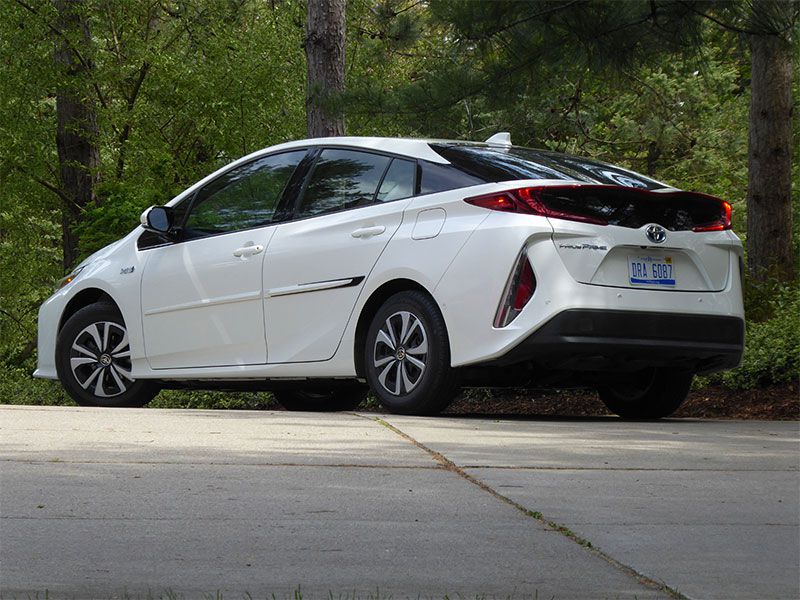
Photo by Ron Sessions
3) It's super comfortable inside.
The Prime offers an upscale interior with generous use of piano black trim, metallic accents and padded and soft-touch surfaces. Outward visibility to the front and sides is excellent with the extensive glass area. The front seats are all-day comfortable with ample bolstering and multi-density foam padding. You sit in them, not on them. Continued from previous Prius models is the full-color central information display arrayed across the top of the dash. A head-up display (HUD) is included on Prime Advanced models. Prime Premium and Advanced models also come with a cordless inductive phone charger pad at the front of the console for Qi-compatible phones.
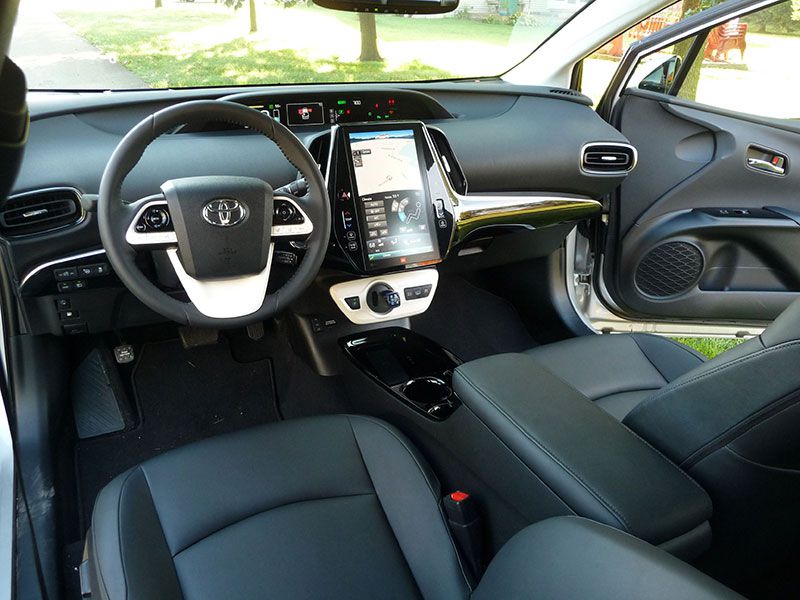
Photo by Ron Sessions
4) It's got a really big touchscreen.
Okay, so it’s not the gigantic 17-inch display as in the Tesla Model S luxury sedan, but the 11.6-inch Entune premium audio center display that’s standard in Prime Premium and Advanced models is bigger and bolder than most everything else out there. The color touchscreen provides easy access to infotainment, navigation and climate control functions. Quick key “buttons” just outside the perimeter of the screen provide easy access to frequently used functions such as temperature control, audio volume, and defroster.
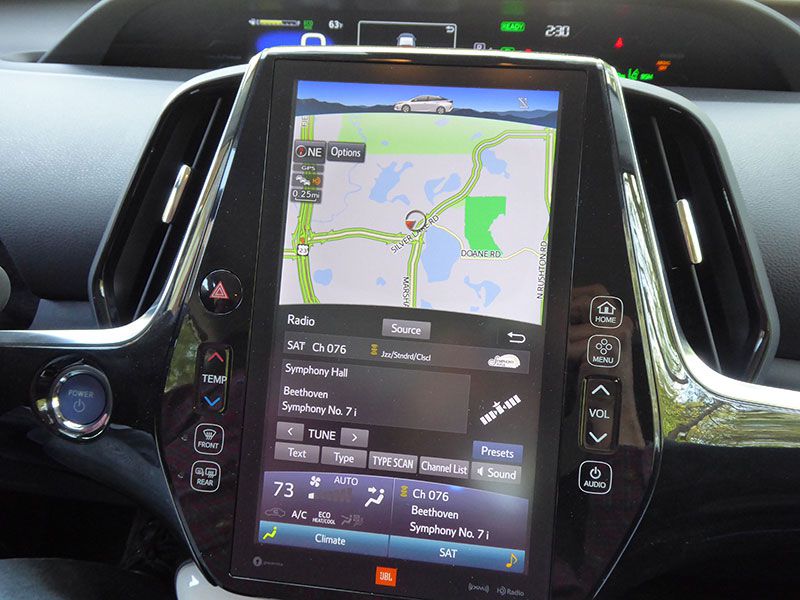
Photo by Ron Sessions
5) It's a four-passenger car.
The Prius Prime is a four-seater. But the upside is that there are no bad seats in this surprisingly roomy midsize hybrid. Instead of a three-across bench with a virtually unusable rear center seat (as in the Chevy Volt), the Prime offers two buckets and a center console with a comfortable armrest and a pair of cup holders back there. Headroom is also generous, with enough room for six-footers.
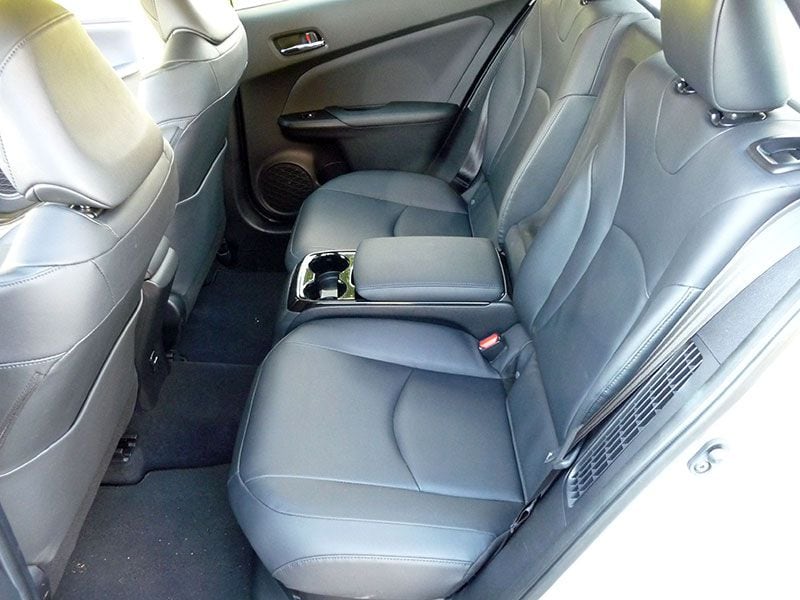
Photo by Ron Sessions
6) There's less cargo space than in the Prius liftback.
Despite the added length, there’s slightly less cargo space in the Prius Prime than in the standard Prius. That’s due to the larger lithium-ion battery which you can see by the raised floor. Still, at 19.8 cubic feet, the Prime’s cargo bay is almost twice as large as the Chevy Volt’s 10.6 cubic-foot stowage area. And it’s accessed via a large hatch opening. A standard pull-out cargo tonneau cover hides valuables from sight.
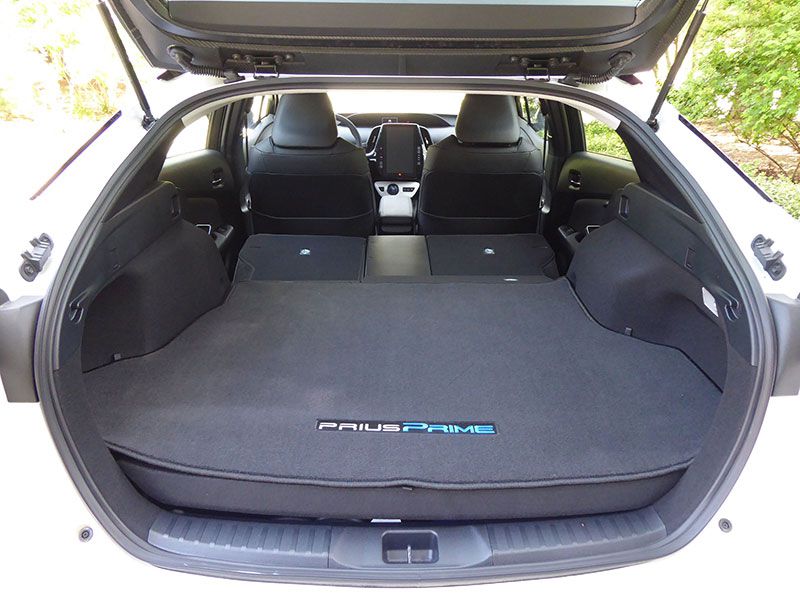
Photo by Ron Sessions
7) That droopy rear window really is functional.
As on the regular Prius Liftback, the Prime’s rear hatchback glass is augmented by an “oven door” window at the back of the cargo area to aid rearward visibility, especially of pedestrians or other cars close to the back bumper. In the Prime, the liftback glass dips down in the center further improving the visibility of items directly in back of the car.
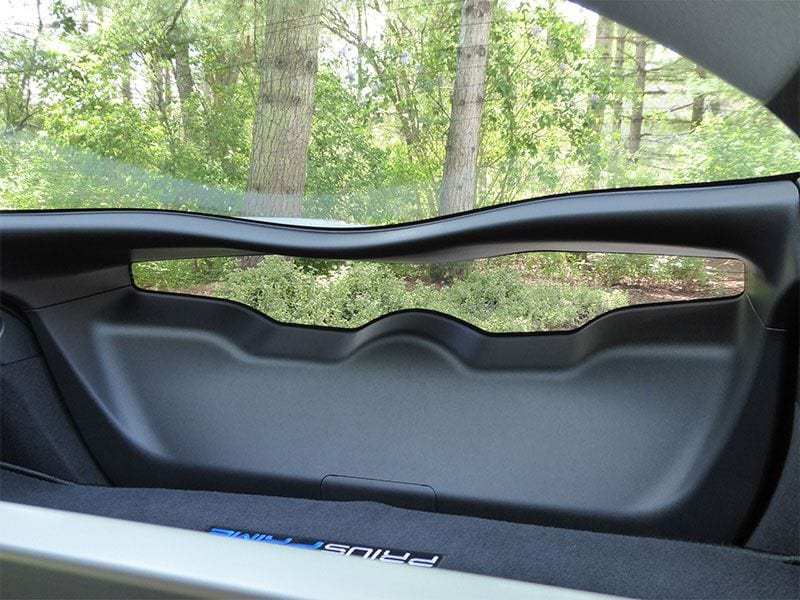
Photo by Ron Sessions
8) It runs on regular unleaded.
Now in its fourth generation, Toyota continues to refine the Prius’s hybrid system, now combining the thrust of a 95-hp 1.8-liter gasoline engine and a pair of electric motors for 121 system horsepower. The 11-second 0-60 mph performance may not be earth-scorching but, wait, that’s the point. The electric-motor drive-off feel from a stop is very satisfying as is the headline-grabbing 133 MPGe EPA fuel-economy rating. Of course, you have to plug it in to get the big numbers. But even if you get lazy and just drive the Prius Prime like a regular hybrid (where the engine keeps the battery charged), look for real-world fuel economy in the low 50s. Not too shabby. And best of all, unlike the Chevy Volt which requires premium fuel, the Prius Prime sips less-expensive regular unleaded that saves you money every time you go to the pump.
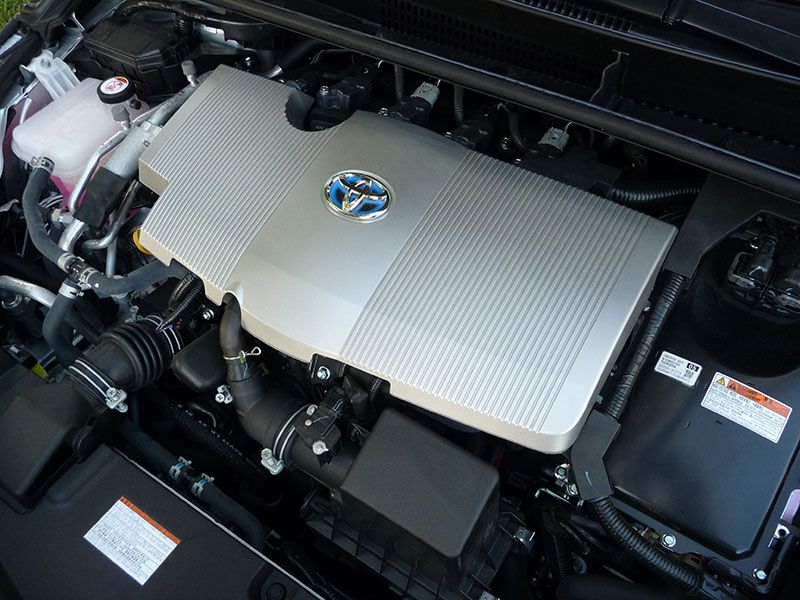
Photo by Ron Sessions
10) It handles like a mainstream car.
Despite the narrow 195/65R15 tires that prioritize low rolling resistance and thus fuel economy over ultimate grip, the Prius Prime’s handling is surprisingly mainstream. Those are words of praise for a hyper-economy car whose earlier versions handled as quirky as they looked. The Prius Prime’s suspension uses a new multilink rear setup introduced just last year on the Prius Liftback and it does a decent job of taming untoward body motions. There’s an organic quality to the Prime’s electrically boosted steering as well, although effort remains artificially light. Toyota continues to improve its blending of hydraulic and regenerative braking with the Prime the latest beneficiary.
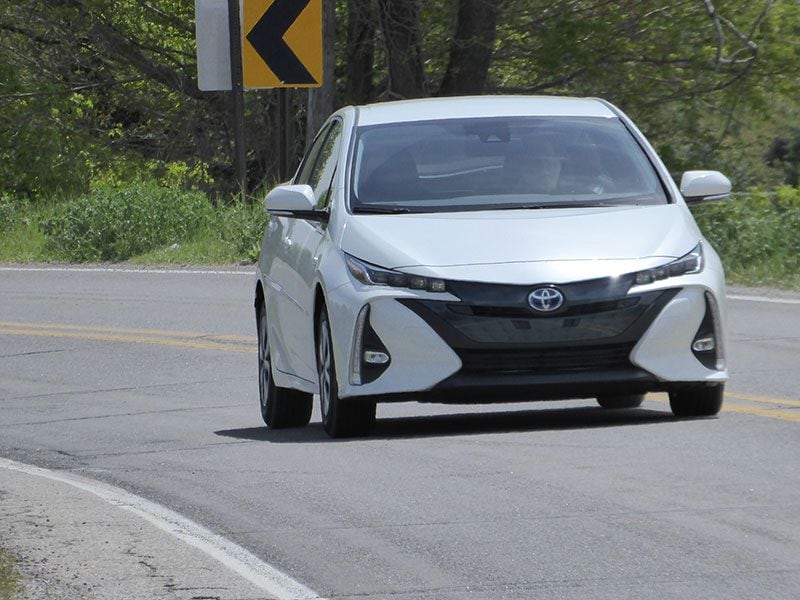
Photo by Ron Sessions
Latest Safety Systems Onboard
Just between the gearshift indicator and speedometer/current fuel economy readouts in the digital instrument panel, it's hard to ignore this crimson warning. The Prius Prime’s standard automated pre-collision emergency braking will flash and beep this warning if it senses a collision with an object or pedestrian is imminent and apply the brakes to avoid or mitigate the impact if the driver ignores it. Other Prius Prime standard semi-autonomous safety tech includes a lane-departure alert with steering assist and full-speed dynamic cruise control. Prime Advanced models also get blind spot and rear cross-traffic alert systems as well.
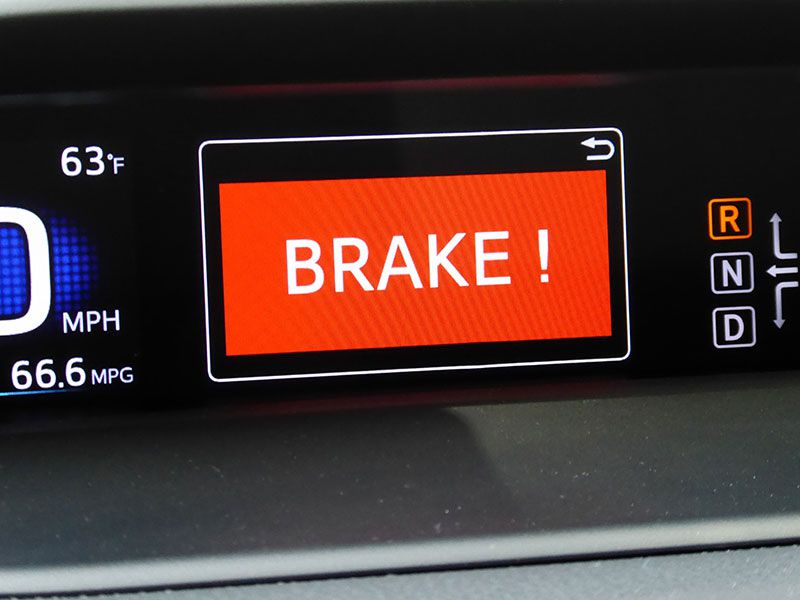
Photo by Ron Sessions